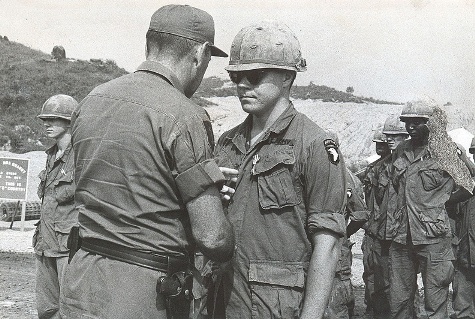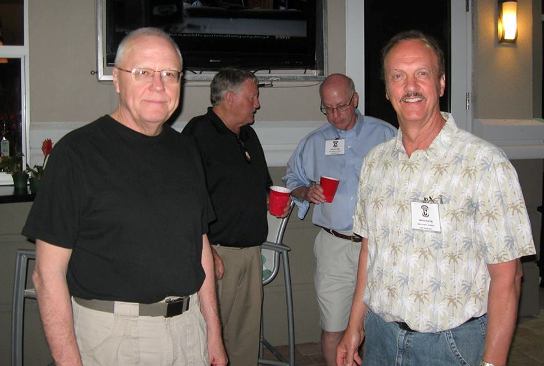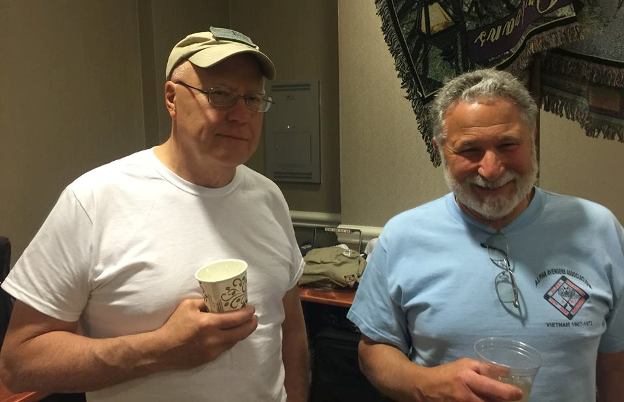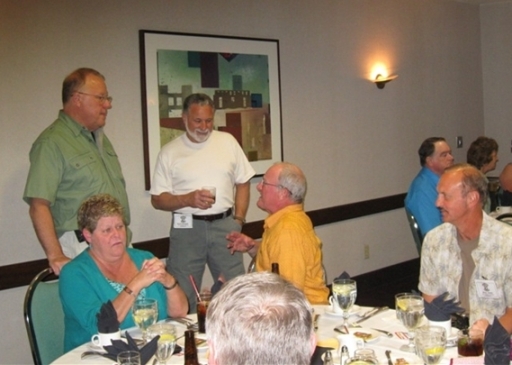


ROGER BARSKI
Roger's deployment was 22 June 1968. He was listed on our April 1969 Roster. Several Originals were still "In Country" when Roger arrived in Vietnam. He is a survivor of FSB Airborne. More about Airborne here. |
 |
| MEDALS AND AWARDS Silver Star Medal National Defense Service Medal Vietnam Service Ribbon Vietnam Campaign Medal Combat Infantryman Badge UNIT CITATIONS |
 Roger-Barski-Gen-Zais-FSB-Boyd |
PHOTOS
  |
  |
|
AFTER ACTION REPORT SAPPER ATTACK ON FSB AIRBORNE - 13 MAY 1969 After 2-17 Air Cavalry, working in the A Shau Valley, met stiff resistance and uncovered numerous large caches in bunkers, the 3d Bde, 101st Abn Div committed A/3-187 to search the area and to begin construction of Fire Support Base Airborne. A/2-501st Infantry was brought into the area on 8 May and assumed responsibility for security. FSB Airborne is located on the eastern lip of the A Shau Valley on the north end of a long ridge running parallel to the valley. A small knoll about 50 to 75 feet higher than the fire base is located to the east and is incorporated into the defense plan. The west and northwest sides of the fire base fall away at a very steep rate making an approach from this direction extremely difficult. The northeast, east and south approaches are gradual slopes and offer the best avenues of approach into the fire base. The fire base itself is very small. The approximate dimension are 25 meters wide and 200 meters long; the mortar position on top of the knoll is circular with a 50 meter diameter. The vegetation in the immediate vicinity of the fire base was destroyed, but the rain forest is only two to three meters from the wire, partially thinned due to air strikes and artillery, but still very thick. The fire base is layed out in the shape of a shoe sole with a detached mortar position on the small knoll to the east. Three strands of concertina wire encircle the fire base with trip flares interspersed irregularly in the wire. Located on Airborne on the night of 12 May 1969 were Company A, 2-501 commanded by CPT Gordon C. Johnson, Company E (-), 2-501 commanded by CPT Alan J. Spoors, Battery C, 2-319 Artillery (four tubes of 105mm) commanded by CPT William W. Beverly, and C/319 FDC. Each of these forces had areas of responsibility in the overall defensive plan. Routine harassing and interdicting fires and an occasional illumination round were fired by the artillery units until about 0300 hours. On 13 May 1969 at 0330, VC/NVA forces commenced an all out attack on Fire Support Base Airborne. The attack was conducted with stealth until the attacking force on the north had cut through the three strands of concertina on the perimeter. Then a burst of AK-47 fire signaled the attack. The perimeter on the NW, NE and east side of the Fire Support Base erupted with heavily concentrated RPG and mortar fire. The mortar rounds were walked across the perimeter and then back and forth across the FSB. The sapper force was already inside the 1st Platoon of A Company and the artillery battery on the northern portion of the fire base. The platoon CP and the bunkers on either side of the CP were immediately destroyed by satchel charges. Communication with the Company CP were destroyed. Charlie Battery (4 tubes, 105mm howitzers) received the brunt of the attack; the CP and the FDC was destroyed and all four tubes were put out of action. The battery was hit so rapidly that there was no time to react. Satchel charges demoralized, disrupted and destroyed the command and control elements. The battery was unable to get off a single round in its defense. Sergeants Barski and Counts, the 2nd and 1st squad leaders of the 1st Platoon, had pulled back, reorganized and reestablished a defensive line. The platoon leader, Cushing, who had been wounded in the initial wave of satchel charges, and recovered enough to realize that his communications with the Company CP had been destroyed, moved to the company CP to report his situation. He arrived back at CP at 0345 and was placed under a medic's care. Captain Johnson then contacted SGT Barski, whose squad was still under RPG, mortar and AK-47 fire, but was holding its ground and reestablished control. The 2nd Platoon, under LT Pitts and located on the eastern edge of the fire base, had been alerted by the exploding satchel charges in the 1st Platoon area, also had a trip flare ignited in front of their position. Immediately, RPG rounds from 20 to 30 meters away made direct hits on the three of the bunkers. However, this attacking force of NVA had been delayed in coming up the hill probably by the thick underbrush or trees blown down, and were exposed cutting through the last strand of concertina. The 1st Platoon immediately engaged the enemy with small arms fire and by rolling grenades down the slope. Twelve NVA were left hanging on the wire, one with wire cutters still grasped in his hand, and another with a 9mm pistol and flare gun. This ended the attack on the 2nd Platoon except for the continuous mortar and RPG fire. E Company (-), a mortar platoon, and the 2nd and 3d Squads from he 3d Platoon, A/2-501, all which held the small knoll on the east side of the fire base, received a two prong attack from the NE and NW. The 81mm mortar platoon continued to fire illumination and HE fires throughout the conflict. The VC/NVA force penetrated into the perimeter far enough to capture an M60 machine gun and then were repulsed. It was the actions of individuals of this element in braving heavy enemy fire and delivering continuous illumination and HE rounds which helped considerably to hold back the attack. Had the NVA forces gained control of this knoll and set up a base of fire into the Airborne proper, they would have been firing down the throats of the men defending the fire base. The southwest and other artillery batteries were not hit by the ground fire, however, they were in the mortar pattern which delivered fire throughout the attack. The 155mm battery; C/2-11 (4 tubes), had one tube disabled due to a direct hit by 82 mm mortar during the barrage, but continue to fire direct fire and illumination with the remaining three tubes during the contact. The sappers did mange to ignite the powder bags of the 155mm battery and by 0430 the northern portion of the perimeter was bathed in a brilliant glow. The composite battery of C Battery, 2-319 (2 tubes) and B Battery, 2-319 Artillery received mortar rounds, and one sapper wearing a white cloth around his forehead ran from the north side of the perimeter through the 155 howitzers, by the Company CP, into the composite battery, flung two satchel charges, and turned around and ran the entire distance back. Several men including CPT Johnson saw him, but were unable to bring him down with small arms. By 0500 a flare ship (Spooky) and other gunships were on station to lend their fire support to the action. The nearby fire bases were also lending their tubes to the fire and incoming mortars were silenced. LT Pitts, who had decimated and stopped the NVA attack in his area, took seven men to reinforce to SGT Barski's squad. The enemy attack, though, had run out of steam, and the combined force of Pitts and Barski was able to push to the outer perimeter. At 0530 the battle was over. The enemy left 39 bodies and 2POW's (one died later of wounds), 17 individual weapons and 1 crew-served weapon on the battlefield. The US force suffered 22 KIA, 61 WIA, 1 M60 machinegun captured, and 5 artillery pieces damaged. The enemy force was later identified to be composed of elements from two separate battalions. These battalions were identified by the two POW's as the 806th Battalion and the K12 Sapper Bn. The force directly involved in the attack probably consisted of 113 men with additional elements of 2 battalions providing support. At least two mortar locations were identified. The enemy had planned the attack for 4 days and had conducted an excellent reconnaissance of the area. They knew exactly where the points were that they desired to destroy and how to get there. The attacking force moved into their attacking positions at last light on the 12th of May. The attack was scheduled for 0100 hrs, but probably due to slow movement it did not commence until 0330. The enemy launched his attack on three primary axis, it was reported that a diversionary attack had commenced at the same time from the south, but no real evidence in this area could be located. The 90mm RR at the south end of the perimeter fired continuous suppressive fire with the Fleshet round, which could have acted as a deterrent. The attack was conceived, planned and executed in the typical, thorough fashion of a well trained sapper unit. A stealthy approach, a violent execution lasting approximately 90 minutes, and then a hasty withdrawal leaving a covering force in contact. Most of the tip flares in the wire had been neutralized by tying down the striker with a bamboo strip. The enemy dead were well equipped with satchel charges, dressed in loin cloths or shorts, though several were completely naked. They also wore the head band to prevent sweat from getting in their eyes. They were well built, well fed husky men with fresh haircuts. The weapons captured were AK47's with folding stocks, M2 sub machineguns (US) a B41 rocket launcher, a 9mm pistol and flare gun. The VC/NVA force was very systematic in their attempts to completely destroy the one battery. A satchel charge would be thrown into a bunker and if any of the wounded men would moan or make noises, a second and third charge would follow until all sound had ceased. The Fire Directions Center (FDC) of C Battery, 2-319, an exposed Conex container, was hit by an RPG round and the men inside began screaming and moaning. One NVA stood on the south side of the container and fired thirty to forty rounds into the Conex. CPT Freeman, the battery CO and battery 1st Sergeant were killed in this action. This NVA soldier was later killed by a member of the 2nd Squad, 1st Platoon, A/2-501. Lessons are being learned and relearned in the Vietnam theater, and the one lesson, that seems to crop-up time and time again, is the increased need for security. Security must be active in the form of patrols and ambushes, and passive in the form of wire, claymores, listening posts and increased alertness during the hours of darkness. This area was known as an NVA warehouse. In two separate caches found within a two kilometer radius, one contained 1,000 RPG rounds and another, 12,800 lbs of bagged, polished rice. All evidence pointed toward the fact that the NVA would attempt to defend the area. Therefore, the need for security was even greater than in a normal exposed fire base. The enemy suffered heavily in this attack, had he been detected prior to entering the perimeter, his losses may not have increased but our losses would have been less. |
|
Webmaster - Barth "Shortround" Cunico |